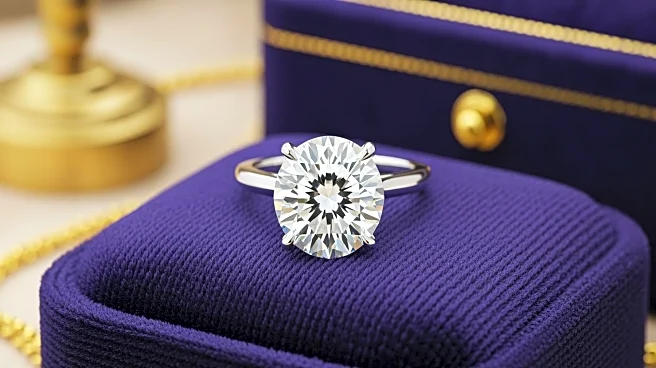What's Happening?
Feriel Zerouki, President of the World Diamond Council, has noted a significant shift in consumer preferences from lab-grown diamonds back to natural stones. This change is attributed to an oversupply of lab-grown diamonds, primarily from increased production
in China and India, leading to a collapse in their prices. Zerouki, speaking at a mining conference in Luanda, emphasized that the price drop has severely impacted consumer confidence in synthetic gems. Industry analyst Edahn Golan reported that the average wholesale price of lab-grown diamonds has plummeted by up to 96% since 2018. The decline in prices has led experts to suggest that lab-grown diamonds may soon be relegated to fashion accessories rather than competitors in the bridal market. Zerouki also mentioned the Luanda Accord, an initiative by diamond-producing countries to promote natural diamonds through a collective marketing fund.
Why It's Important?
The shift in consumer preference from lab-grown to natural diamonds has significant implications for the diamond industry. The oversupply and subsequent price collapse of lab-grown diamonds could lead to a reevaluation of their market position, potentially affecting manufacturers and retailers who have invested heavily in synthetic gems. The resurgence of natural diamonds, supported by marketing initiatives like the Luanda Accord, could bolster the economies of diamond-producing countries such as Angola, Botswana, and South Africa. This transition may also influence the bridal market, where natural diamonds have traditionally held sway, impacting consumer choices and industry strategies.
What's Next?
The diamond industry may see increased efforts to promote natural diamonds, as evidenced by the Luanda Accord. This agreement involves diamond-producing countries allocating a portion of their sales revenue to marketing campaigns for natural stones. As consumer confidence in lab-grown diamonds wanes, retailers and manufacturers might pivot their strategies to emphasize the unique qualities of natural diamonds. The industry could also witness further price adjustments and market shifts as stakeholders respond to changing consumer preferences.
Beyond the Headlines
The decline in lab-grown diamond popularity raises questions about sustainability and ethical considerations in the jewelry industry. While lab-grown diamonds were initially marketed as a more sustainable and ethical alternative to mined diamonds, the oversupply and price collapse challenge their viability. This situation may prompt discussions on the environmental impact of diamond production and the ethical sourcing of natural stones, potentially influencing consumer behavior and industry practices in the long term.














